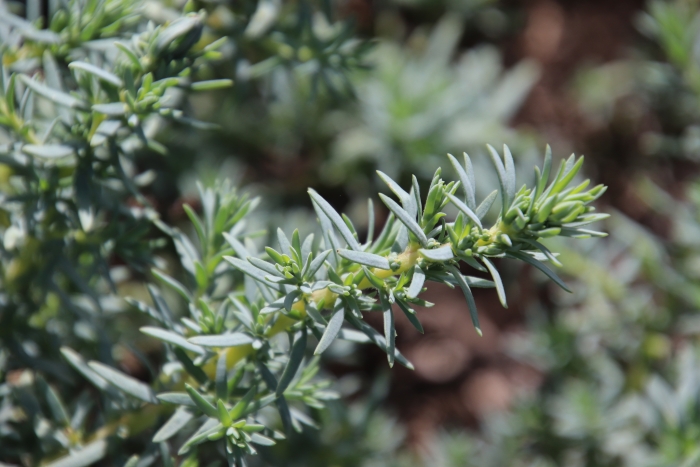Woolly Seablite
(Suaeda taxifolia)
Woolly Seablite (Suaeda taxifolia)
/
/

Millie Basden
CC BY 4.0
Image By:
Millie Basden
Recorded By:
Copyright:
CC BY 4.0
Copyright Notice:
Photo by: Millie Basden | License Type: CC BY 4.0 | License URL: http://creativecommons.org/licenses/by/4.0/ | Rights Holder: Millie Basden | Publisher: iNaturalist | Date Created: 2019-03-07T11:42:43-08:00 |

























Estimated Native Range
Summary
Suaeda taxifolia, commonly known as woolly seablite, is a perennial subshrub native to saline habitats along the coastline of southern California and Baja California, including salt marshes, coastal dunes, and saline scrub. It exhibits a variable growth habit, often growing erect but sometimes spreading, and can reach up to 5 feet in height. The stems of woolly seablite range from waxy and hairless to densely hairy, and it bears fleshy, lance-shaped leaves that vary in color from green to reddish. During its flowering season, which occurs from late summer to fall, it produces clusters of inconspicuous flowers along the stems, each with fleshy, hairy sepals and no petals, followed by a utricle fruit that is a type of dry, indehiscent fruit enclosed within the persistent perianth.
Woolly seablite is valued for its ability to thrive in harsh coastal environments, providing critical habitat for wildlife and contributing to erosion control on unstable soils. It is often used in restoration projects and as a natural barrier against wind and sea spray in coastal landscapes. In cultivation, it requires minimal maintenance, tolerating high salinity, drought, and poor soil conditions. It prefers full sun exposure and can adapt to various soil types, provided they are well-drained. While not commonly found in ornamental horticulture, its unique texture and foliage color can add interest to water-wise gardens and xeriscapes.CC BY-SA 4.0
Woolly seablite is valued for its ability to thrive in harsh coastal environments, providing critical habitat for wildlife and contributing to erosion control on unstable soils. It is often used in restoration projects and as a natural barrier against wind and sea spray in coastal landscapes. In cultivation, it requires minimal maintenance, tolerating high salinity, drought, and poor soil conditions. It prefers full sun exposure and can adapt to various soil types, provided they are well-drained. While not commonly found in ornamental horticulture, its unique texture and foliage color can add interest to water-wise gardens and xeriscapes.CC BY-SA 4.0
Plant Description
- Plant Type: Shrub
- Height: 1-3 feet
- Width: 2-4 feet
- Growth Rate: Moderate
- Flower Color: N/A
- Flowering Season: Spring, Summer, Fall
- Leaf Retention: Deciduous
Growth Requirements
- Sun: Full Sun
- Water: Medium
- Drainage: Medium, Fast
Common Uses
Drought Tolerant, Low Maintenance, Salt Tolerant
Natural Habitat
Native to saline habitats along the coastline of southern California and Baja California, including salt marshes, coastal dunes, and saline scrub
Other Names
Common Names:
Scientific Names: , Suaeda taxifolia, Dondia brevifolia, Dondia taxifolia, Suaeda brachyphylla, Suaeda brevifolia, Suaeda californica var. pubescens, Suaeda californica var. taxifolia, Suaeda taxifolia subsp. brevifolia, Suaeda taxifolia subsp. taxifolia,
GBIF Accepted Name: